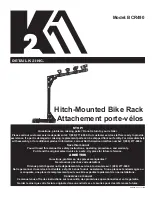
4.
ASSEmbLy
Except for the cradle assemblies, this
product is shipped from the factory in a
disassembled state.
Make some room at the rear of your
vehicle. Although once assembled,
the bike rack is easy to slip into your
hitch receiver. For simplicity, the initial
assembly is best done directly onto the
back of the vehicle.
Remove everything from the carton
and check the components against
the parts list, familiarizing yourself with
them as you go. Do this in a cleared
space near the rear of your vehicle.
Retain packing materials until you are
sure all parts are present and in good
condition.
1.
Refer to the schematic drawing on
page 3.
2.
Insert the end of the Lower
horizontal attachment tube (item
17) with two holes drilled into it, into
the 2 in. hitch receiver tube of your
vehicle. Note there is a washer-like
tab inside the vehicle-side end of
the Lower horizontal attachment
tube.
3.
If your vehicle has a 1-1/4 in. hitch
receiver, first assemble the 1-1/4”
to 2” hitch receiver adapter (item 1)
to the Lower horizontal connector.
4.
Align and insert the 1-1/4 in. hitch
adapter into the 2 in. (51 mm)
square hitch tube on the bicycle
carrier. Note there is a washer-
like tab inside the lower horizontal
connector that allows you to insert
the adapter only one way.
5.
Secure the adapter to the hitch
tube using the Anti-wobble locking
bolt (item no. 16) and R clip (item
no. 2).
6.
Slide the 1-1/4 in. square hitch
adapter into your vehicle’s 1-1/4
in. hitch receiver. Fasten it using
a second Anti-wobble locking bolt
(item no. 16) and R clip (item no. 2)
7.
Close the other end of the Lower
horizontal attachment tube by
inserting item 15, Square pipe cap.
8.
Attach the two sides of the 90º
bracket (item 5) to the Lower
horizontal attachment tube using
two hex head bolts (item 3), four
washers, (item 4) and two nylon
insert lock nuts (item 14).
v.131208
7
ENGLISH
FRANÇAIS
3.
utIlISEz uNIQuEMENt DES
PIèCES Et ACCESSOIRES
D’éQuIPEMENt D’ORIgINE.
Consultez le manuel du
propriétaire. L’utilisation
d’accessoires non conforme peut
produire des risques imprévus.
ASSEmbLAGE
Sauf pour les ensembles de berceau,
ce produit est livré depuis l’usine en
pièces non assemblées.
Libérez de la place à l’arrière de votre
véhicule. Même si une fois assemblé,
le porte-vélos est facile à glisser dans
votre récepteur d’attelage. Par souci
de simplicité, l’assemblage initial est
préférable d’être fait directement sur la
face arrière du véhicule.
Retirez tous les éléments du
cartonnage et vérifiez que toutes
les composantes soient incluses
en utilisant la liste des pièces,
familiarisez-vous avec toutes les
composantes dans un espace dégagé
près de l’arrière de votre véhicule.
Conservez les matériaux d’emballage
jusqu’à ce que vous soyez sûr que tout
est inclus et en bon état.
1.
Reportez-vous au dessin en vue
explosée à la page 3.
2.
Insérez l’extrémité du connecteur
horizontal inférieur (article n
o.
17)
avec les deux trous dans l’attelage
2 po. (51mm) du récepteur de votre
véhicule.
3.
Si votre véhicule a un récepteur
d’attelage un 1-1/4 po, d’abord
assembler l’Adaptateur pour
récepteur d’attache 1-1/4 po to 2 po
(article 1) au connecteur horizontal
inférieur.
4.
Alignez et insérez l’adaptateur
d’attelage 1-1/4 po dans le tube
d’attelage de 2 po (51 mm) placé
sur le porte-vélos. Remarquez, il y
a un onglet en forme de rondelle à
l’intérieur du connecteur horizontale
inférieure qui vous permet d’insérer
l’adaptateur seul sens.
5.
Fixer l’adaptateur sur le tube
d’attelage en utilisant la Goupille à
pression (article n
o.
16) et l’attache
en forme R (article n
o.
27).
6.
Faites glisser le 1-1/4 po
adaptateur d’attelage place dans
votre véhicule de 1-1/4 po attelage
de remorque. Fixer à l’aide d’une
Summary of Contents for BCR490
Page 3: ......












